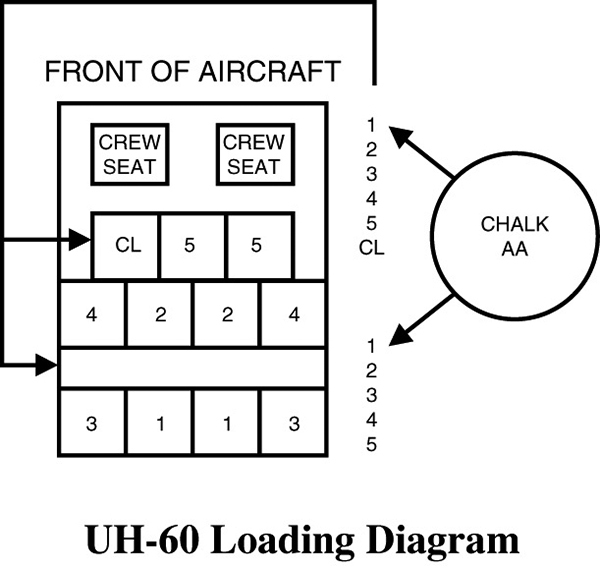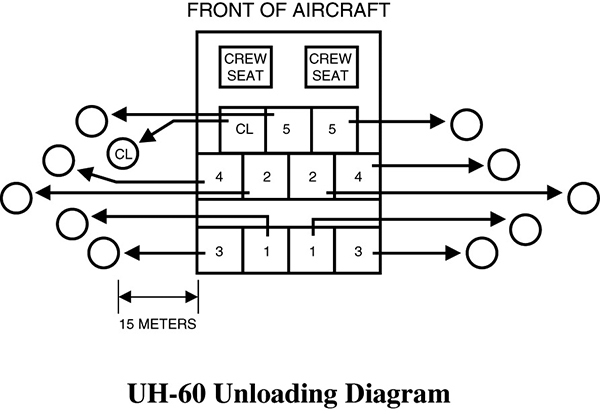Planning must cover the organization and operation of the PZ, including load positions, day and night markings, and communications. The loading plan is most important when mixing aircraft types. Ground and aviation unit movement to the PZ is scheduled so that only the troops to load and the helicopter to be loaded arrive at the PZ at the same time. To coordinate movement of units to the PZ, assembly areas, holding areas, and routes of movement are selected.
At company and lower levels, each man and major items of equipment or supplies are assigned to specific aircraft by an airloading table. The airloading table is a loading manifest for each aircraft and serves as an accountability tool. When time is limited, the table can be a sheet of paper from the squad leader’s notebook. These lists are left with a specified person in the PZ. This procedure ensures that if an aircraft is lost, a list of personnel and equipment on board is available.


During load planning, unit leaders attempt to maintain the following:
•Tactical integrity of units. Fire teams and squads are loaded intact on the same aircraft, and platoons in the same serial. This ensures integrity as a fighting unit upon landing.
•Self-sufficiency of loads. Each load should be functional by itself whenever possible. Every towed item is accompanied by its prime mover. Crews are loaded with their vehicle or weapon. Ammunition is carried with the weapon. Component parts accompany the major items of equipment. Sufficient personnel are on board to unload the cargo.
•Tactical cross-loading. Loads should be planned so that all leaders or all crew-served weapons are not on the same aircraft. Thus, if an aircraft is lost, the mission is not seriously hampered.
Aircraft Bump Plan. Each aircraft load has a bump sequence designated on its airloading table. Bump priority ensures that the most essential personnel and equipment arrive at the objective area first. It specifies personnel and equipment that may be bumped and delivered later. If all personnel within the load cannot be lifted, individuals must know whom to off-load and in what sequence. This ensures that key personnel are not bumped arbitrarily.
Bump sequence is also designated for aircraft within each serial or flight. This ensures that key aircraft loads are not left in the PZ. When an aircraft within a serial or flight cannot lift off and key personnel are on board, they off-load and reboard another aircraft that has priority. A PZ bump and straggler collection point is established to account for, regroup, and reschedule these personnel and/or loads for later delivery.
Lifts, Serials, and Loads. To maximize operational control, aviation assets are designated as lifts, serials, or loads.
A lift is one sortie of all utility and cargo aircraft assigned to a mission. Each time all assigned aircraft pick up troops and/or equipment and set them down on the LZ, one lift is completed. The second lift is completed when all lift aircraft place their second loads on the LZ.
When a lift is too large to fly in one formation, it is organized into a number of serials. A serial is a tactical grouping of two or more aircraft under the control of a serial commander and separated from other tactical groupings within the lift by time or space. Serials also may be organized when the capacity of available PZs or LZs is limited, or to take advantage of available flight routes.
A load is personnel or equipment designated to be moved by a specific aircraft. Each aircraft within the lift is termed a load. For example, within a lift of ten, there are aircraft loads one through ten.
Staging Plan
The staging plan is based on the loading plan and prescribes the arrival time of ground units (soldiers, equipment, and supplies) at the PZ in the order of movement.
Helicopters
Several types of helicopters may be used in air assault operations: observation, utility, cargo, and attack.
Observation Helicopters (OHs). OHs are used to provide command and control, aerial observation and reconnaissance, and aerial target acquisition.
Utility Helicopters (UHs). UHs are the most versatile of all helicopters, performing a variety of tasks. As such, they are available in almost every unit possessing helicopters. UHs are used to conduct combat assaults and provide transportation, command and control, and resupply. When rigged with special equipment, they also can be used to provide aeromedical evacuations, conduct radiological surveys, and dispense scatterable mines.
Cargo Helicopters (CHs). These aircraft are organic to corps aviation units. They normally provide transportation, resupply, and recovery of downed aircraft.
Attack Helicopters (AHs). AHs are organized in groups varying in size from company to battalion and can also be task organized to meet mission needs. They are used to provide overwatch and security, destroy point targets, and suppress air defense weapons.
Capabilities. Under normal conditions, helicopters can ascend and descend at relatively steep angles; this enables them to operate from confined and unimproved areas. Troops and their combat equipment can be unloaded from a helicopter hovering a short distance above the ground with troop ladders and rappelling means, or if the helicopter can hover low enough, the troops may jump to the ground. The troop ladder can also be used to load personnel when the helicopter cannot land. Cargo can be transported as an external load and delivered to areas inaccessible to other types of aircraft or to ground transportation.
Because of their wide speed range and high maneuverability at slow speeds, helicopters can fly safely and efficiently at low altitudes, using terrain and trees for cover and concealment. With their ability to fly at high or low altitudes, decelerate rapidly, maintain slow forward speed, and land nearly vertically, helicopters also can operate under marginal weather conditions. Helicopters can land on the objective area in a tactical formation, LZs permitting. Night and/or limited-visibility landings and liftoffs can be made with a minimum of light. Helicopters flying at low levels are capable of achieving surprise, deceiving the enemy at the LZs, and employing shock effect through the use of suppressive fires. Engine and rotor noise may deceive the enemy as to the direction of approach and intended flight path.
Limitations. The high fuel consumption of helicopters imposes limitations on range and allowable cargo load (ACL). Helicopters may reduce fuel loads to permit an increased ACL, but reducing the fuel load also reduces the range and flexibility. The load-carrying capability of helicopters decreases with increases in altitude, humidity, and temperature. This limitation may be compensated for through reduction of fuel load. Weight and balance affect flight control. Loads must be properly distributed to keep the center of gravity within allowable limits.
Hail, sleet, icing, heavy rains, and gusty winds (30 knots or more) limit or preclude the use of helicopters. Crosswind velocities above 15 knots for utility helicopters and 10 knots for cargo helicopters, and downwind velocities above 5 knots for either type affect the selection of the direction of landing and liftoff.
Engine and rotor noise may compromise secrecy. Aviator fatigue requires greater consideration in the operation of rotary-wing aircraft than in the operation of fixed-wing aircraft.
Loads
The type-load method is the most efficient method used in the conduct of air assault operations and in operational planning. Army aviation units are frequently required to support numerous major units operating over expansive tactical zones. Standardization of type loads within the theater of operations ensures responsive and effective air mobility with a minimum of time required for planning.